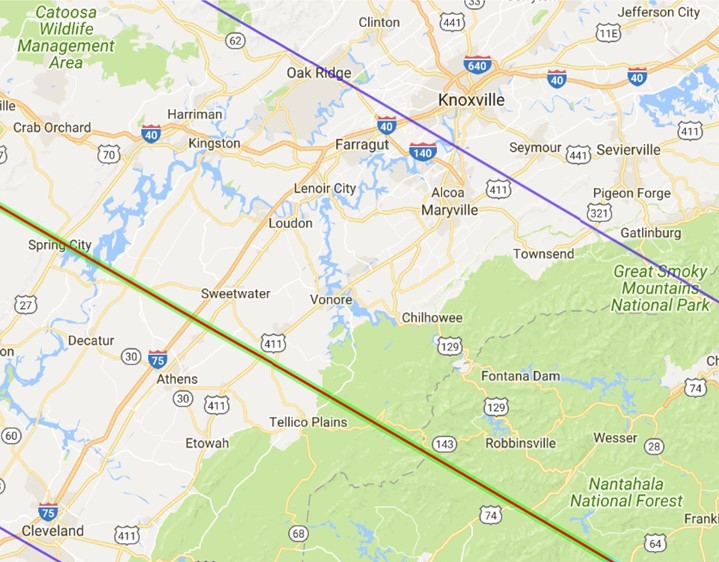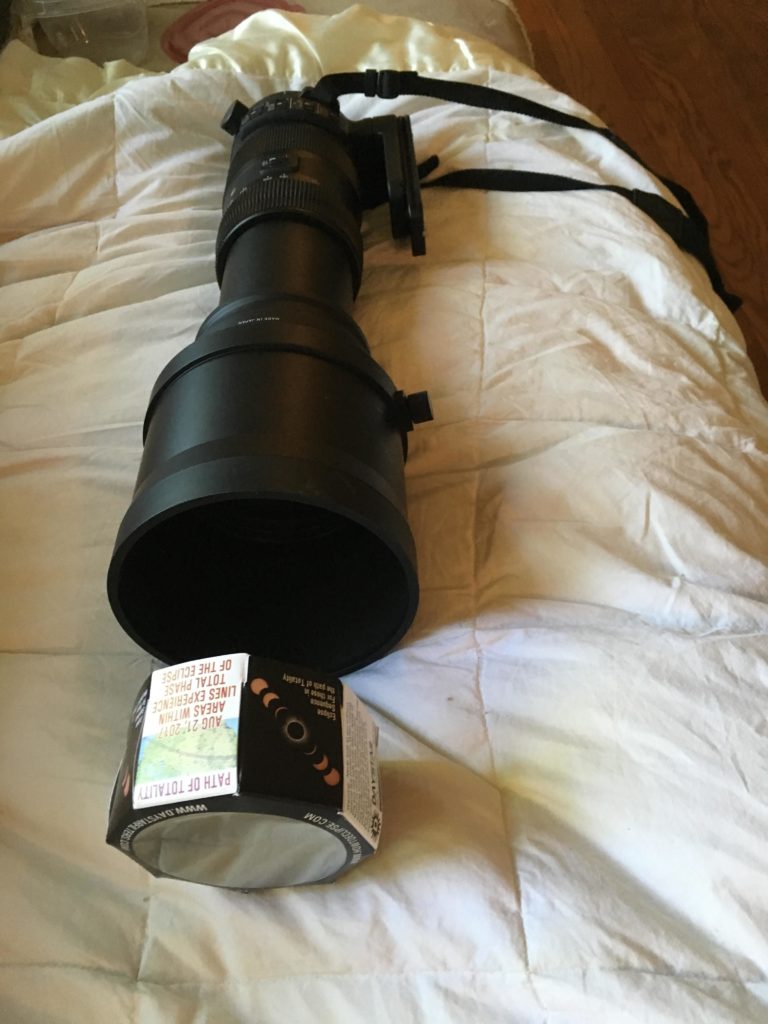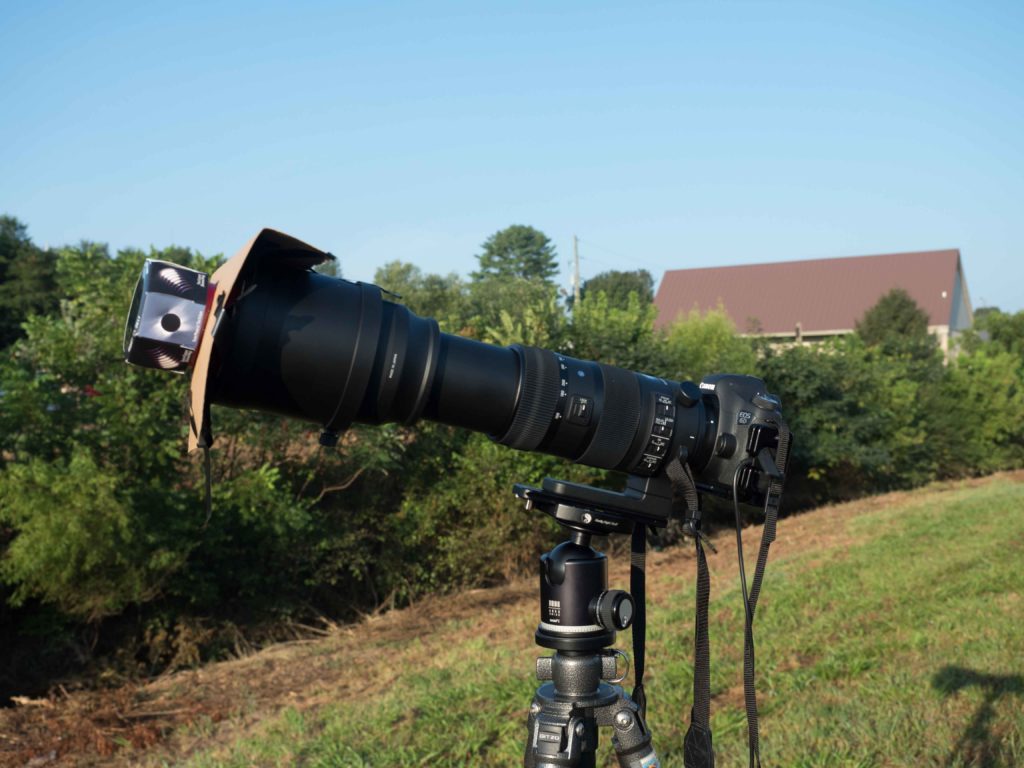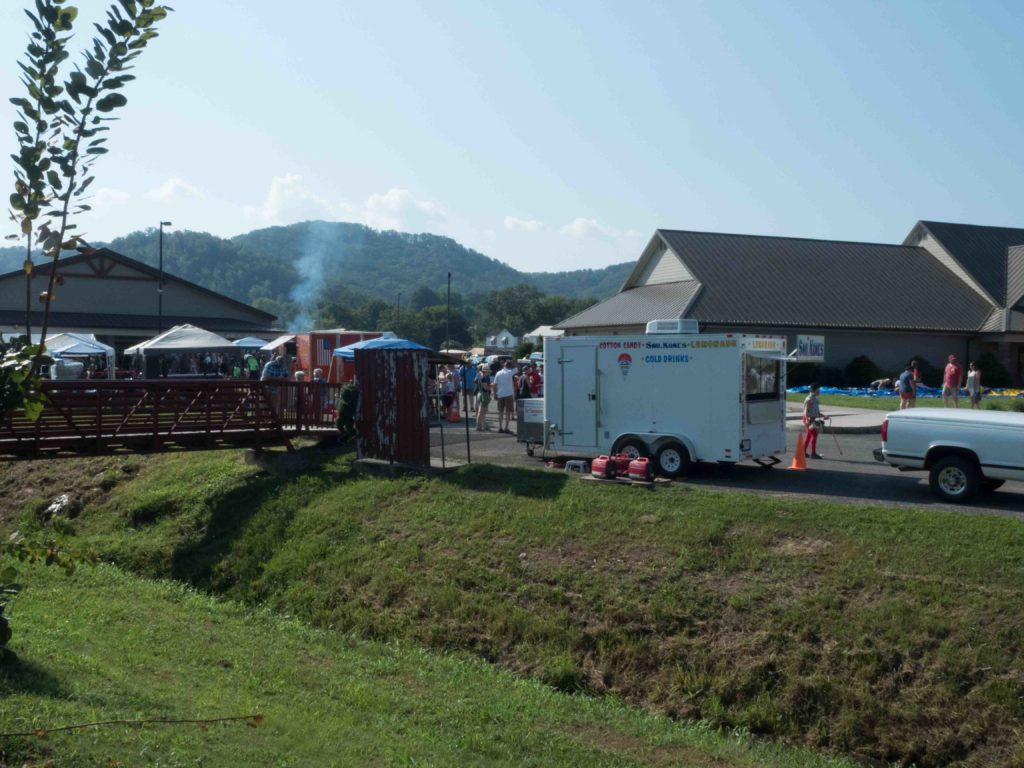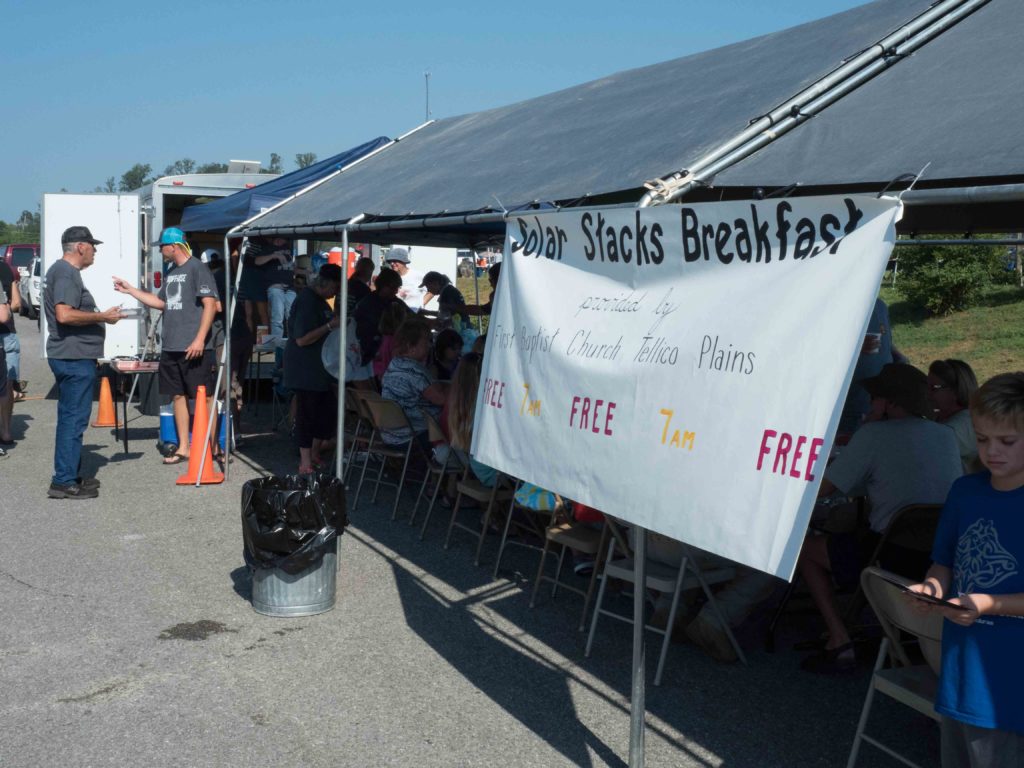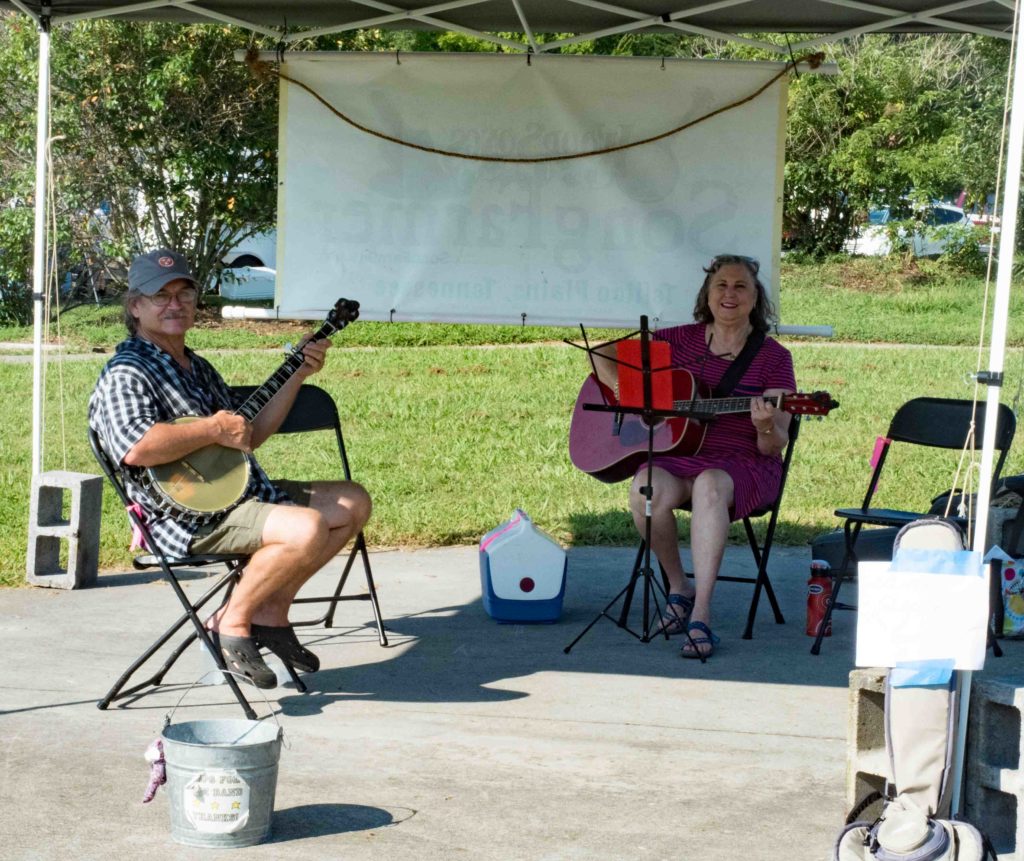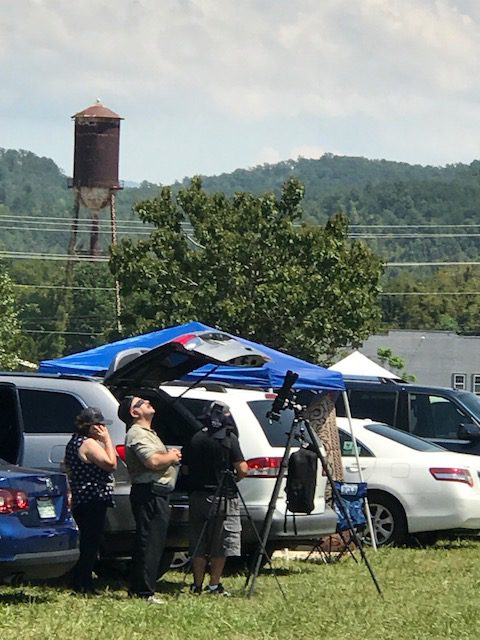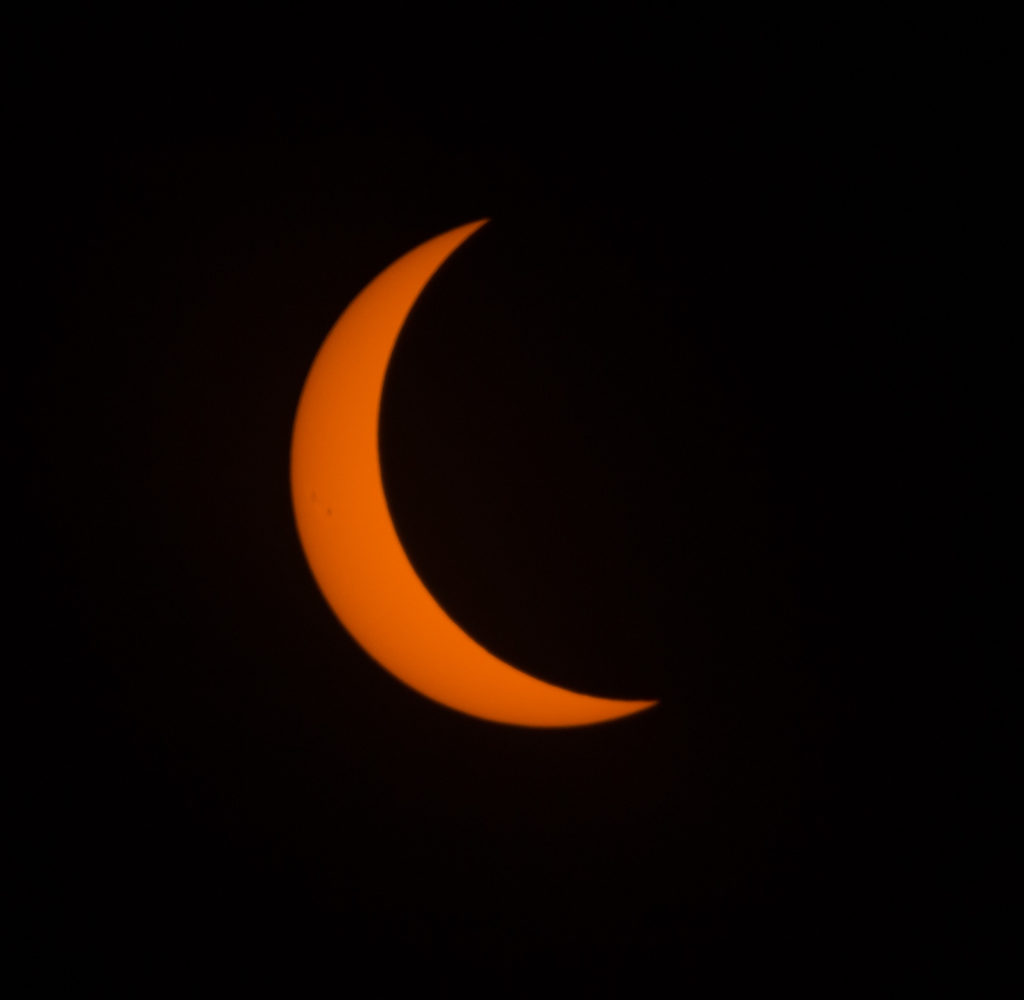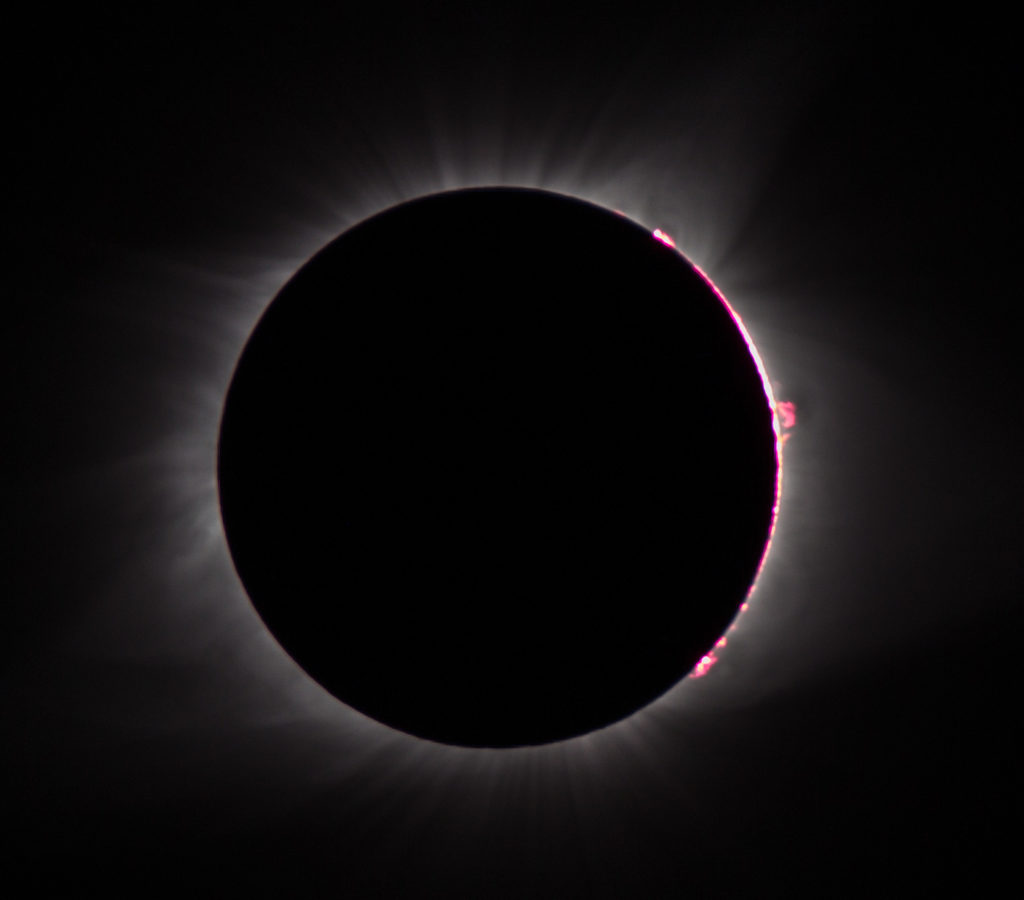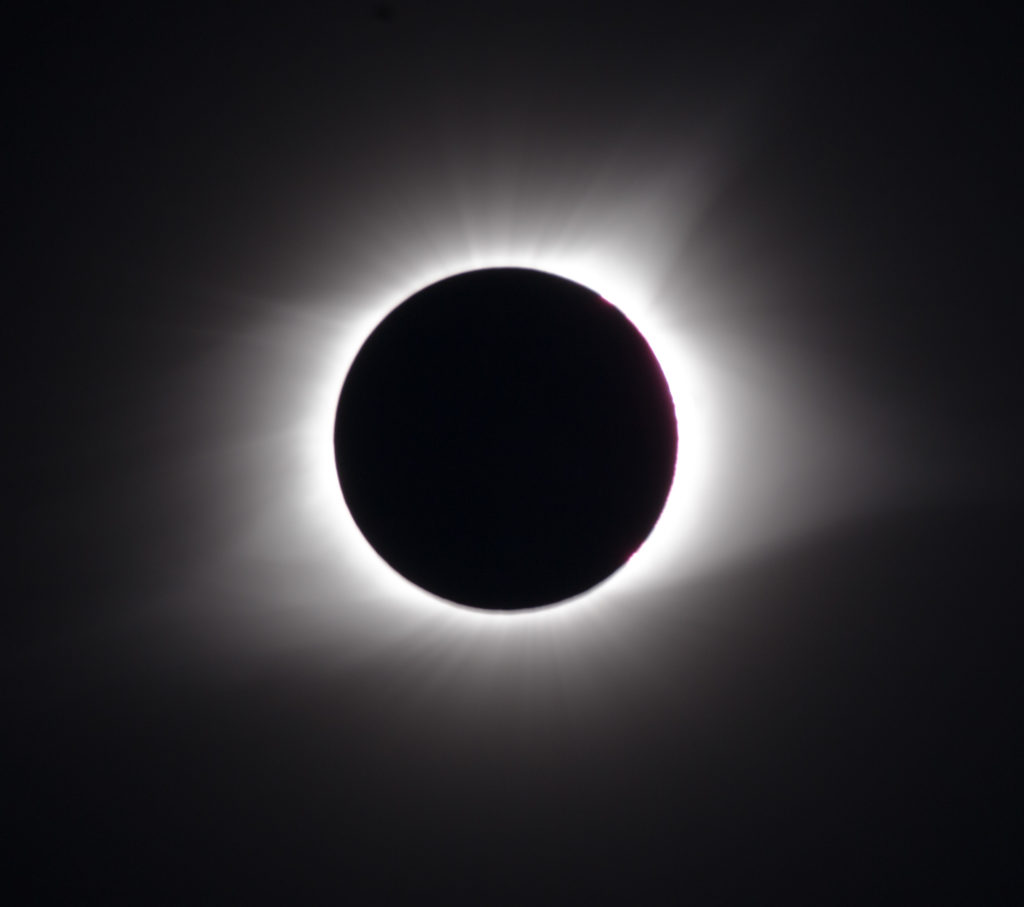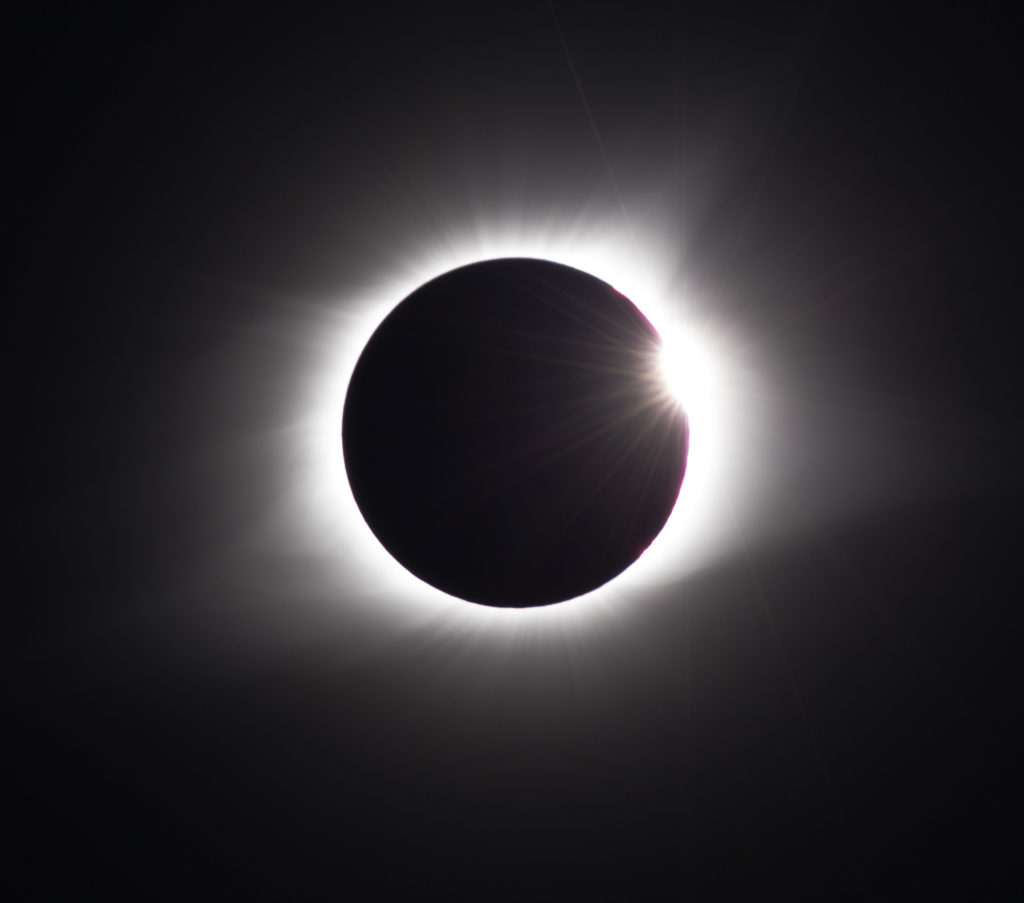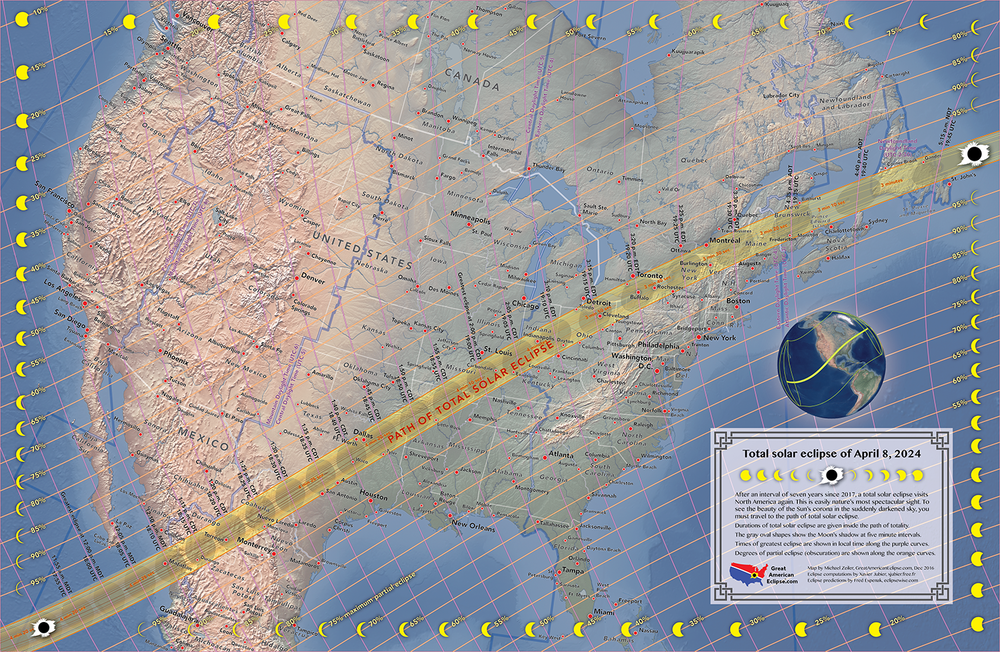“No battle plan survives contact with the enemy.”
– Helmuth von Moltke, German Military Strategist
I really wanted to see the total solar eclipse on Monday, August 21, but was torn all summer on where to go. I saw that airfares had skyrocketed to locations out west that had high probabilities of being clear in August, and hotel prices were crazy too. My father-in-law called and offered me a tempting stay at his house, plus a ride from the airport in Kansas City to totality. I deferred my decision until the week before the eclipse, even knowing that hotel rooms everywhere were becoming scarce as hen’s teeth. I saw that Kansas City was looking bleak on the weather forecasts, while Tennessee was looking better every day. Hotels within the totality band in Tennessee were virtually full, with some notable four digit price exceptions.
On Friday I decided that Knoxville (a city of 200,000 people and many hotels) would be a good jumping off point near the path, and almost a tie for minimum drive distance from the D.C. area. I made a hotel reservation, which sounds easier than it was. I eventually located a reasonably priced room in a nice hotel and booked two nights, Sunday and Monday – a good thing, as it turned out. Meanwhile, the forecast still looked good – sunny at noon on Monday, becoming partly cloudy in the afternoon. It just depended on which part was going to be cloudy, fingers crossed.
My wife, BJ, loaned me her Honda Pilot to stow a beach chair, beach umbrella, camera gear, water, food, and luggage. I wasn’t so sure that I’d be finding food or water wherever I ended up on Monday. The Pilot worked out very well. It turned out that I was able to stage my gear during the eclipse from the back of the SUV.
I brought my Canon 6D with a Sigma 150-600 mm f/5.0-6.3 as my “totality camera and lens”. I did not score a solar filter for its large 105 mm aperture, and reserved it for totality when I didn’t have a sun to filter. The 600 mm would be excellent for capturing the blocked disk of the sun and the extended corona.
I did want to photograph the partial phases leading up to the eclipse too, and brought my Olympus micro 4/3 camera (OM-D, EM-5, Mark II) and an Olympus Zuiko 70-150 mm f/2.8 with 1.4x teleconverter. This provided a maximum equivalent of 420 mm for a full frame DSLR, which was good as well. I did manage to acquire a solar filter that fit this lens. I had solar glasses and solar filters for my binoculars. I brought a medium zoom for my Olympus to get crowd and venue shots. I had two tripods, one for each camera. I had a remote shutter release for the Canon that I could set up to automatically take shots all through totality.
I left home at 6:30 a.m. on Sunday and got to Knoxville at 3:00 p.m. I then researched the little towns close to the maximum totality line. Here is what I was looking at using the NASA interactive totality map. The two blue lines enclose all locations that experience totality, and the central green/red line has the maximum duration (i.e. 2 minutes, 38 seconds). Locations near the blue lines have only a moment of totality, so best to stay clear of those:
Naturally, I looked from Knoxville south along Highway 40 to Highway 75, down to near the maximum totality line. I spotted Sweetwater and, to the west a bit, Spring City off Highway 27. Both of these towns had web sites and Facebook pages touting their eclipse plans! They had parking areas and shuttle buses. They had food vendors and bands. They had the press and maybe even some celebrities coming. But apparently, many people had seen all of this well before I did, and had committed to being here before Mother Nature had made her plans.
The towns were overwhelmed by the avalanche of people coming according to their Facebook comments. There was no longer any parking available – it was all reserved. They were worried that there would be 50 mile traffic jams on Highways 75, 40, and 27. Homeowners were selling space in their yards for $100, and they ran out of space – people were asking the homeowners if they could use their roofs too. They were anticipating cell service to crash. It was illegal to pull over and watch from the sides of the highways – electronic road signs every few miles said so. I started to sweat.
I then looked far to the east, up against the mountains and the Nantahala National Forest, and spotted a town close to the maximum totality called Tellico Plains. Highway 411 looked a little off the beaten path to me, so maybe it wouldn’t jam up early in the morning. They had a Facebook page for the eclipse too. They had planned a 3 day camping event with astronomers and lectures at their Charles Hall museum, plus $5 parking on Monday, starting at 6:00 a.m. with no reservations. They had porta johns, food trucks, water, security, and medical. It looked like a less likely place to try to get to than the other towns – more on the fringes of humanity. I had no question that I was going there. I spent the rest of the evening reviewing my planned camera settings.
On Monday at 3:15 a.m. I woke up realizing that since my best camera and biggest lens had no solar filter, I would be forced to try to find the black disk that used to be the “sun” in a small piece of a big sky with the high magnification of that lens. And I’d have to do this while my 2 minutes and 38 seconds was ticking by. I realized that this was a very bad idea. I hauled myself out of bed. I needed to be able to find the sun during the partial eclipse using a filter (knocking the filter off when the eclipse went total). Somehow I needed to get my 89 mm diameter solar filter onto the 120 mm diameter Sigma lens hood with no light leaks using only what I had in my hotel room:
I got up and scoured my room. It was Apollo 13 time. (“We have to make this … fit into the hole for this … using nothing but that.”)
I found a paper coffee cup, cardboard from the back of my 8×11″ pad of paper, and some electrical tape in my kit. Using my “MacGyver” knife, I cut the bottom off the cup, and cut a hole in the cardboard, and slid the cup into it for a tight squeeze. I cut “flaps” into the bottom sides of the cup, and folded and taped them in place on the underside of the cardboard. The cup was secure. The solar filter fit perfectly on the top of the cup – pure luck. I then had a couple of strips of electrical tape to keep the folded top of the cardboard sheet attached to the lens hood. Here is my fielded solution:
Classy, huh?
I left the hotel at 4:45 a.m. and got to Tellico Plains at 6:00 a.m. along with the earliest arrivals. I encountered a line of one car. I got an excellent parking space on the southern edge of the field, just feet from the porta potties (didn’t want to walk away from $1000’s in gear for too long). As the sun considered coming up, I met the various people parked near me. Dave, Lisa and girls were from Fairfax, VA, and Gene was from Dayton, OH. We all had cameras, long lenses, and tripods except for those with telescopes. Some of the telescopes were exotic, working with just excited hydrogen emissions from the sun, and I got a peek at the turbulence on the sun’s surface!
Tellico Plains had an excellent venue ready for us.
Church ladies were serving free hot cakes and sausages!
And a trio played folk music – here are two of them:
The sky stayed clear! The field steadily filled with hundreds of vehicles until they closed entry sometime after 9:00 a.m. There was a stopped line of cars on the road that went further than I could see. It became hot and humid. I set up my beach chair and umbrella. That helped. A lot of people brought large canopies. Everyone was happy and relaxed. A drone went up and recorded the show.
After noon, with about an hour until the eclipse started, we all started lining up our cameras with the sun. The sun was higher than 65 degrees elevation, so you couldn’t even easily bend down to look through the viewfinder (bad idea, unless it is a digital viewfinder) or Live View screen. We had to splay our tripod legs, tilt the tripods back, and sit on the ground under the cameras. It was still hard to find the sun in Live View. You had to have correct camera aperture and shutter speed for the sun when using a solar filter, or it might be too dark to see. And you had to steer the lens to a small spot of sky that was too bright to directly look at without protection. Then once you got it, you had to adjust it every few minutes as the sun moved. Here are some nearby folks getting started (before they discovered that they were going to sprain their neck with their Live View):
I was sweaty, dirty, and uncomfortable. Here is me before the eclipse. Note my small Olympus, lens, and filter at high elevation over my left shoulder. That’s my neighbor, Gene, from Dayton, under the towel (he had a failed memory card just before totality, and I loaned him one):
As mentioned above, I was planning to use my Olympus camera and lens with the solar filter for the partial eclipse, then switch to my Canon camera and Sigma lens for totality. But after the partial eclipse started at 1:04, I soon found that the quality was awful! I don’t know why. I quickly changed plans and moved the filter onto the Sigma lens with my handy-dandy adapter, and found the sun. One issue though – my lens and camera weighed more than 8 pounds, so whenever I loosened the tripod ballhead to move the lens as the sun moved, it wanted to swing down forcibly. Sometimes I had to find the sun again from scratch.
The quality was enormously better! I stayed with this new plan. Here is an example from the partial eclipse (unprocessed, but cropped):
When totality was a minute away I switched to my planned camera settings to capture the corona at 7 different exposures in a bracketed sequence. I got my remote shutter release ready to kick off an indefinite number of shots so that I wouldn’t have to do anything except watch!
The sky dimmed quickly in the last few seconds, the cicadas got noisy, the temperature dropped, Bailey’s Beads appeared on the limb of the moon as the sun set through the lunar mountain valleys, and suddenly it was dark. A black disk appeared where a sun used to be, and the corona exploded across the sky. The crowd cheered, the street lights came on, and the cicadas got quiet.
I looked at my setup, and realized that it was alarmingly dim should anything not go to plan. I pushed the remote shutter release button and … nothing happened in the camera – dead quiet. A little beep sounded once each second as the remote signaled a command to what it presumed was the camera shutter. I looked at the camera and saw that my filter was still on. I quickly knocked it off – a rookie mistake in the excitement of the moment.
Still, the “beep”, “beep”, “beep” counted down my remaining time. No “click”, “click”, “click”. What was wrong? Then, as my eyes adjusted to the dark, I saw that the remote cable had fallen out of the camera, probably during one of my realign-with-the-sun efforts. I hit the shutter button on the camera itself and heard 7 bracketed shots go off. OK, I was back in business. I checked the Live View screen and saw the eclipse departing off the right edge of the screen. I had to move the lens again. I admired the eclipse while I was down there. I pushed the shutter button again, and got a good set of seven. I continued. I looked up at the eclipse numerous times, totally amazed. It was other-worldly. The forces on display were awesome.
Soon it was all over, but I pushed the shutter button one last time as the sun was emerging to get a “diamond ring” shot. Here are a few early favorites, at least before I roll up my sleeves in processing later:
Many people were packing up after totality. I stayed and got the partial eclipse phases to the very end. After all that work and travel? Of course.
I checked Google Maps with the traffic indicator turned on. Dark red (stop and go) was the color of choice for dozens of miles on every major road out of there. I found a pretty winding two-lane road through the mountains that allowed me to bypass a couple of hours of it, but eventually I had to get on the highway. The drive back to Knoxville was slow with masses of traffic jamming the roads. I was very glad to have my hotel for another night and spare myself a difficult late night drive.
One thing really impressed me. Tellico Plains had put on this whole thing at a cost to themselves. We were basically invited to come, for nearly nothing. They did it for us!
I still have lots of bracketed exposures to try to combine (via HDR techniques). The visible corona was much more textured, much larger, and more impressive than any of these photos, and truly amazing to see! I hope to better show that with HDR.
Hopefully, I will be able to do it again in 2024, having learned a few lessons from this one. Maybe my new pal, Gene, in Dayton can help me out …

